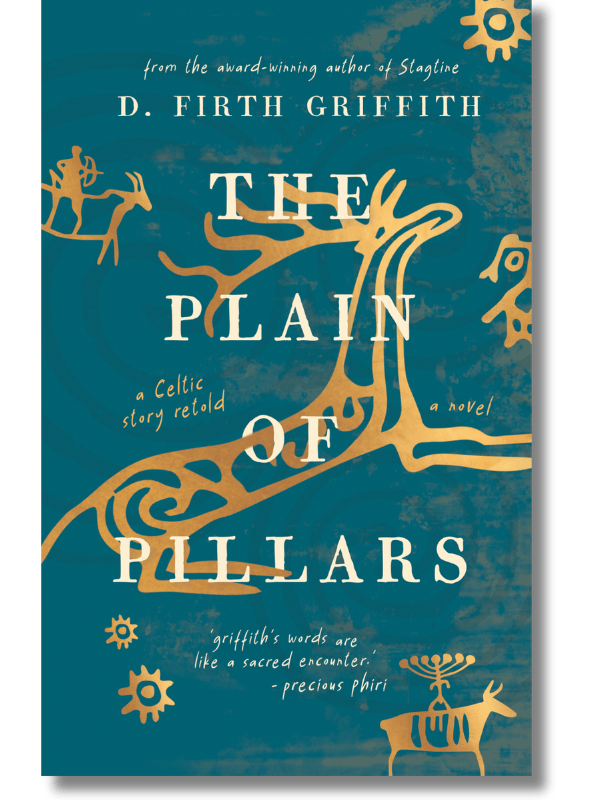The Plain of Pillars
by D. Firth Griffith
Genre: Mythology & Folklore / Celtic
ISBN: 9781735492292
Print Length: 264 pages
Reviewed by Samantha Hui
A sharp critique of colonization, apathy, and individualism
The Plain of Pillars retells Celtic myths and revitalizes ancient folkloric traditions, using classic storytelling techniques to illuminate truths that resonate with contemporary society. Like, humanity may be rushing toward its own destruction—striving for progress without questioning its true direction. And, the worldview of colonization is unimaginative domination; its cure lies in a worldsense of limitlessly creative love.
“‘Harmony is when resonance reincarnates particular truths into universal significance.’”
The town of Siraide exists outside the constraints of time and prioritizes harmony and unity above all else. In this idyllic place, humans are born from flora and fauna, and everything is valued for its service to the community. Even the gods are drawn to take human form, seeking to be part of this interconnected harmony.
However, this peaceful existence is threatened when the Oceaners, a colonizing and vicious force led by their god-king Balor, declare war on Siraide. In contrast to the People of Siraide, the Oceaners elevate their men to the status of kings, glorifying their rulers as divine.
The story follows Long-Arms, a human born from a mare with a golden-tipped mane. His journey toward understanding the creative, peaceful harmony of the People of Siraide just may be the key to defending against the brutal colonization of the Oceaners.
“They removed them from their old language, forced them to cut their hair, and denuded the Land’s Art into knowledge. This is the process of colonization: language, identity, and then relationship.”
The People of Siraide are in direct opposition to the tyrannical rule of the Oceaners. While the Oceaners value power and domination, the People prioritize harmony among all things. The flowers are beautiful, the People are beautiful, and together they embody beauty itself. This harmonious worldview is reflected in their approach to teaching. Long-Arms learns from his mare mother, a raven, and a tree, all of whom teach him through questions. They do not impose knowledge upon him but encourage him to discover his own truth. Their method is one of gentle guidance, helping him reflect on his beliefs and thoughts.
In contrast, the Oceaner prince Breoch is taught by his father, the authoritarian Balor. The Oceaners view teaching as a process of filling the pupil, a mere vessel, with the superior knowledge of the master. There is no room for questioning or independent thought; the pupil must absorb the teachings blindly, without choice or dissent.
“Our bodies are surrendered stars. Light at their end but also, soon, a beginning. Exploding, we die over and over, and that is the role of the pillars—to live once again.”
The People’s reverence for harmony extends to their understanding of life and death, which they view as equal and interconnected parts of a larger cycle. Life and death serve the land as a whole, and when the People die, they do so in peace. The Oceaners, however, die in vain, without resolution or understanding, their lives marked by a lack of harmony.
“Loneliness is dissonance through desolation. It colonizes as it goes. It walks like limits but unnatural like sand rippling over water.”
Griffith demonstrates a mastery of genre fiction and mythology, employing narrative techniques that are both lyrically impressive and philosophically engaging. For example, the narrative is interwoven with the presence of a transforming Raven, who hovers above the unfolding events, bearing witness to the tragedy without intervening. The Raven’s passages serve as a modern-day chorus, much like those in ancient Greek tragedies. These interludes clarify the events for the reader and provide deeper insight into the characters and their motivations. Like a Greek chorus, the Raven addresses the reader directly, and its perspective is the only one presented in the first person.
“‘Fear is faith in the wrong direction.’”
The Raven’s presence is unsettling, for its messages are unambiguous and direct. By speaking directly to the reader, the Raven implicates us in the unfolding tragedy, holding us accountable for the violence of colonization, individualism, and unchecked power. As the Raven’s words confront the reader, they may feel an urge to look away, as though avoiding the symbolic eye contact between them and the narrative’s harsh truths.
“That humans create is true. That humans create well is the eternal question.”
In The Plain of Pillars, D. Firth Griffith weaves a powerful critique of the destructive forces of dissonance and unchecked power, using the timeless language of myth to illuminate urgent truths for the modern world.
Through the contrasting worlds of Siraide and the Oceaners, Griffith explores the transformative power of creative, communal love in the face of violent domination. The story reveals that the battle is not only one of survival but of vision—the vision of a world built on connection, understanding, and the limitless potential of creative love.
As the Raven’s unsettling voice reminds us, we are all implicated in this struggle; the choice remains ours: to blindly follow the path of destruction or to embrace a new way of being—one of empathy, unity, and the courage to question the course of progress.
Thank you for reading Samantha Hui’s book review of The Plain of Pillars by D. Firth Griffith! If you liked what you read, please spend some more time with us at the links below.
The post Book Review: The Plain of Pillars appeared first on Independent Book Review.
